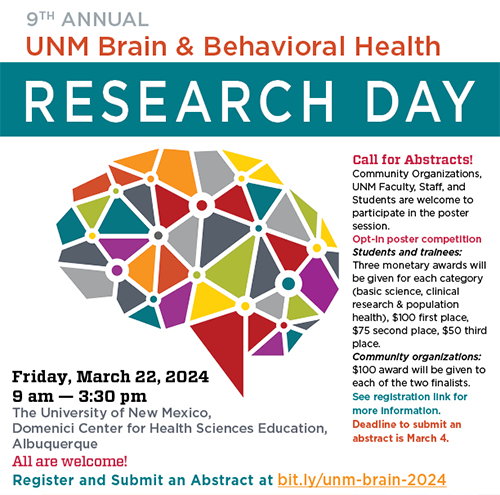Document Type
Poster
Publication Date
3-31-2023
Abstract
Background: The HEALthy Brain and Child Development (HBCD) is a multi-site research study (25 sites) designed to prospectively examine brain and behavioral development beginning prenatally through mid-childhood. The study will determine the impacts of a variety of risk and resilience environmental factors, including prenatal exposure to substances, from a diverse sample of pregnant individuals and their live-born children. The study incorporates repeated neuroimaging and neurophysiological measures (magnetic resonance imaging, MRI). One aspect of the HBCD pilot phase focuses on optimizing non-sedation techniques to facilitate MRI data acquisition in newborns (<1 month) and infants (≤9 months).
Methods: Concerted efforts were devoted to maximize scanning rates in young populations at the national and local levels. At the New Mexico site, an MRI preparation room was developed specifically focusing on families with young children. Participants in both age groups were scanned without sedation at the Mind Research Network (MRN). MRI sequences included structural (T1/T2), diffusion, resting state, quantitative, and MR spectroscopy. Data was transmitted to the HBCD Data Coordinating Center where it underwent QC/QA processes.
Results/Conclusions: Data from 3 newborns and 4 infants were collected. Participants were scheduled for evaluation either during a daily nap or evening sleep times. The highest number of successful frames (framewise displacement < 0.3 mm) for resting state and diffusion scans were 207/261 and 29/76 respectively. With respect to patient-related facilitators, flexibility and adaptability were crucial. A detailed sleep questionnaire helped facilitate success rates. Parents were allowed to stay in the room with the child during the MRI along with a designated baby monitor/RA for the duration of the scan. Additional comforting techniques utilized included debriefing the family, feeding and swaddling, infant immobilizer, use of MRI-safe weighted blanket, deformable wax plugs, pediatric MiniMuffs, and headphones playing white noise, minimizing interaction with the child and a low stimulation environment.
Recommended Citation
Marquez, Lidia Enriquez; Tracey Wick; Crystal Almeida; Alexandria Wiesel; Arvind Caprihan; Ludmila Bakhireva; and Andrew R. Mayer. "A Novel Methodological Approach of collecting MRI in newborns and infants without sedation in a multi-site consortium pilot study." (2023). https://digitalrepository.unm.edu/hsc-bbhrd/90


Comments
Poster presented at the Brain & Behavioral Health Research Day 2023